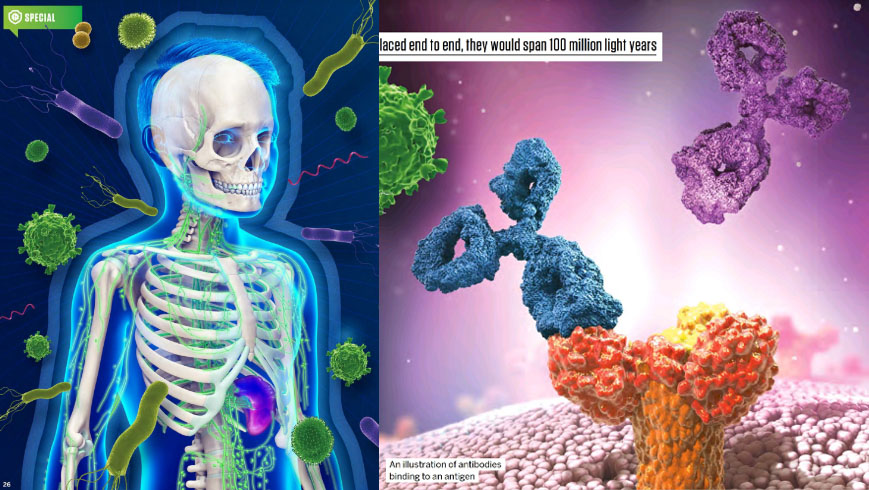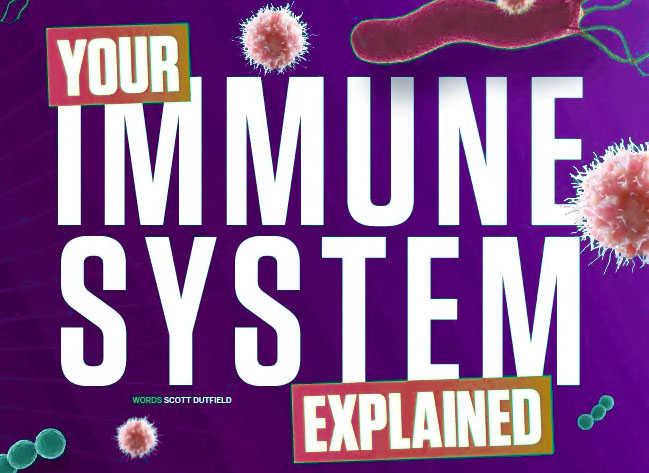Meet the cells and organs that make up your immune system. Discover how it keeps deadly invaders at bay and what happens when it gets out of control
Every day your immune system is working tirelessly to fend off harmful invading pathogens such as bacteria and viruses. Our understanding of the immune system began in the late-19th century when Russian zoologist Élie Metchnikoff identified a group of white blood cells called phagocytes, whose purpose is to seek out, engulf and eliminate pathogens. During the same period, the discovery of antibodies and their role in neutralising pathogens also came to light thanks to German physiologists Emil Behring and Paul Ehrlich. Since then, scientists from around the world have come to understand the complexity of our immune system and the many ways it has evolved to fight off bacterial baddies and villainous viruses.
يقرأ : ثلاث خطوات لجسم أصغر سنا وأكثر صحة
Part of our immune system is passed on to us as newborns from our mothers through the placenta during our time spent in the womb, and again through feeding on breast milk.
Immunity to particular viruses and bacteria and the potency of this passive immunity differs from mother to mother. For example, mothers who have had chickenpox during their lifetime can pass on that immunity to their newborn. However, this form of passive protection is short-lived and begins to decrease after the first few months of life. Over time, the immune system acquires more complex immunities after reacting with pathogens from the outside world.
يقرأ : How Your Immune System Works
Your immune response is divided into systems. The first frontline defence your body has is known as the innate immune system. The skin is our first defence against pathogens and offers a physical barrier around the body. Then there’s mucus. Snot acts like quicksand for pathogens, which become stuck in its grasp and are prevented from making it any further into the body. For those sneaky pathogens that make it past these first two lines of defence, they might find their way into the stomach, which is filled with acid that kills them off. Also, the digestive system is home to healthy bacteria that compete with invading bacteria for space and food, sometimes leading to the demise of the invading bacteria.
يقرأ : SUPERFOODS TO BOOST YOUR IMMUNITY
If a pathogen makes it past these physical barriers, then a secondary internal defence is called upon. In the event that a physical barrier, such as the skin, has been broken and there’s a potential threat of invasion from outside pathogens, white blood cells called mast cells, which are found in the connective tissue near
blood vessels, release histamine into the blood to initiate the body’s inflammatory response.
The first soldiers to battle pathogens are a group of white blood cells called phagocytes. The most abundant phagocytes in the human body are called neutrophils, which gobble up pathogens on sight. Once a pathogen is devoured, the neutrophil essentially selfdestructs in a process called apoptosis, killing the pathogen in the process. During infection, the bodies of self-destructed neutrophils pile up and form pus at the site of a wound.

Outside of the bloodstream, larger phagocytes called macrophages also engulf pathogens, but can be found free-flowing through tissue or embedded into tissues such as the lymph nodes or intestinal tract. If the war against pathogens isn’t going in the phagocytes’ favour, they can release chemicals into the blood called pyrogens to trigger a fever. Once the pyrogens reach the brain’s hypothalamus, they cause it to raise the body’s temperature, giving your immune cells a metabolic boost for battle but inducing stress in pathogens.
In the event that these innate defences can’t completely fend off pathogens, the second division of the immune system, known as adaptive or active immunity, kicks into gear. In this system, a legion of white blood cells called lymphocytes work together to seek out and destroy pathogens that enter the bloodstream. The key elements in the active immune system are antigens and antibodies. Antigens are like the identification cards for pathogens and antibodies are like pathogen mugshots. When the two are compared and a positive match is found, immune cells are altered and the elimination process begins.
يقرأ : 10 Extraordinary Health Benefits Of Sex
Sometimes the volume of invading bacteria can overwhelm the body’s immune system and it can’t produce enough immune cells to fight off a serious infection, such as pneumonia. In this case, the immune system may need a helping hand from medication, called antibiotics, to eradicate bacterial pathogens. Antiviral medication also works to limit the infectious abilities of some invading viruses, giving the immune system a chance to defeat them.
Similarly, vaccines are used to stimulate our natural immune response against specific pathogen threats. Vaccines work by releasing proteins called antigens into the body, which the immune system recognises as foreign and a potential pathogen. The antigen in the vaccine will have the same proteins as that of the pathogen you’re vaccinating against, such as measles. This sets the active immune system into motion, creating antibodies to fight a potential infection. The immune system will store or ‘remember’ the antibodies it needs in case of a future infection.



